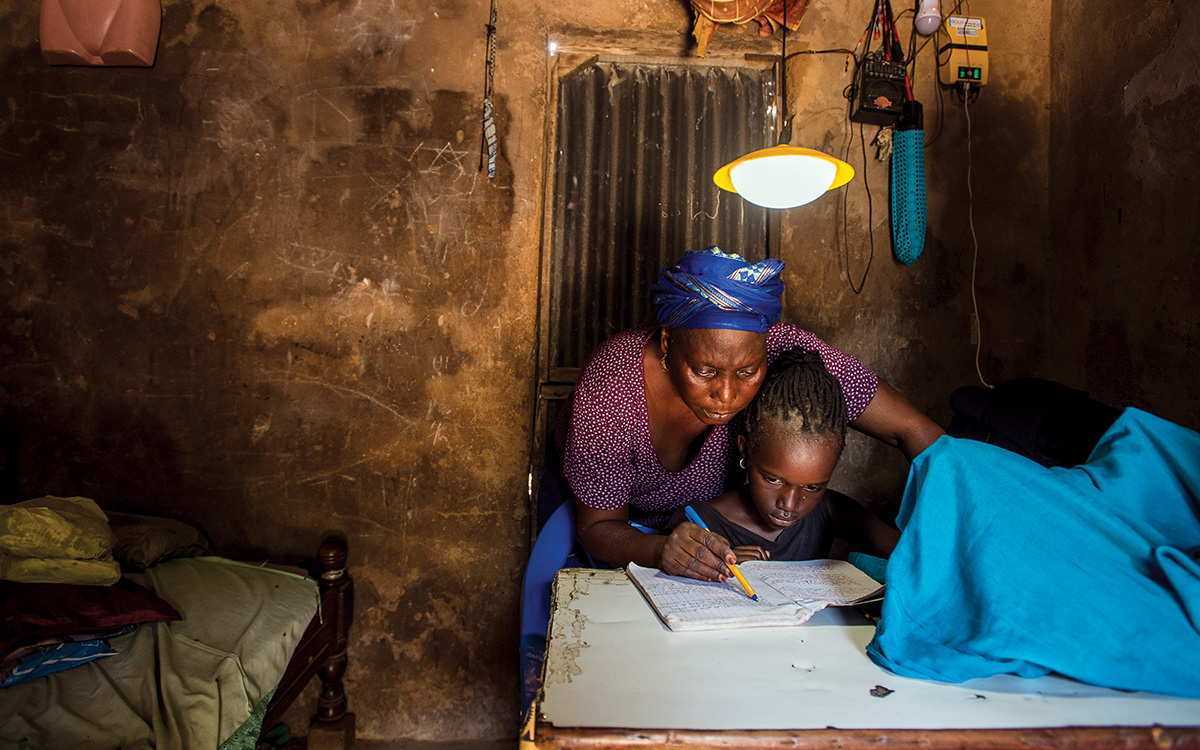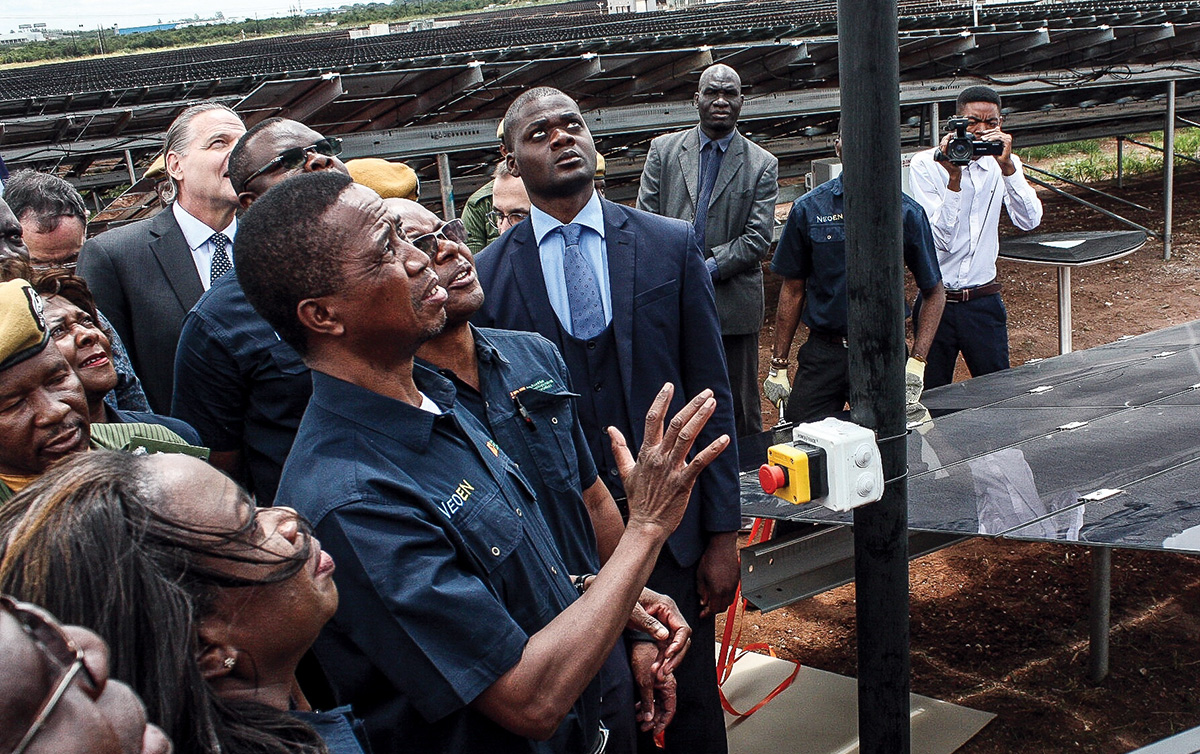Energy Diplomacy Works: How Power Africa Redefines Development Partnerships
An ambitious USAID initiative to bring the U.S. government’s resources to bear to help increase access to electricity in Africa is producing results, offering a new model for development assistance.
BY ANDREW M. HERSCOWITZ

Power Africa helps provide first-time electricity access to homes and businesses in Africa. Here, a young boy studies under a solar lantern at his home in Senegal in October 2017.
Power Africa / Xaume Olleros
“Se fue la luz!” (The power went out!) was the first Spanish phrase I learned as a 16-year-old exchange student in the Dominican Republic in 1987. Power outages were frequent and unpredictable. Of course, lack of electricity was not the only challenge for Dominicans at the time: They also endured weak education and health care systems, a large gap between the wealthy and the poor, and an absence of critical infrastructure throughout the country, among other things.
My experiences in the Dominican Republic—more than 30 years ago, and living with the minister of public works’ family no less—sparked my lifelong interest in economic development. I realized then that access to electricity is fundamental to the social and economic development of any country. Power provides light for children to study into the night. Power gives farmers tools to increase and improve agricultural output. And in the Dominican Republic, it lets Presidente beers chill to just above freezing while merengue and bachata blare over loudspeakers until the morning hours, keeping thousands of small businesses thriving.
Power is life and a cornerstone of economic development.
Answering the Call

Israel’s Prime Minister Benjamin Netanyahu, at left, and Power Africa Coordinator Andrew Herscowitz sign an MOU in Jerusalem in December 2017 for increased cooperation between the government of Israel and Power Africa to increase access to electricity in sub-Saharan Africa.
Power Africa
What I didn’t know then was that, years later, power would be at the core of my work. After a career with a law firm, I joined the U.S. Agency for International Development in 2001 and a year later found myself back in the Dominican Republic, working as a Foreign Service officer. Given my earlier experience with electricity outages there, I was thrilled to work on a project with the National Rural Electrification Cooperative Association to expand rural electrification, introduce modern metering, and attract private sector financing for the metering project.
My work with USAID took me from the Dominican Republic to Peru and, in 2013, to Ecuador, where I served as the mission director. There, as I visited a project in the Galapagos Islands one sunny day, I received a phone call. The proposal was immense: Help develop and lead an ambitious initiative to bring the U.S. government’s collective resources to bear to increase electricity access in sub-Saharan Africa. Days later, I was on a plane to begin what has been an incredible journey, working with more than 170 public and private-sector partners to help bring first-time electricity to more than 74 million people through “Power Africa.”
Power Africa aims to double access to electricity in sub- Saharan Africa to improve lives, strengthen economies, and help people emerge from poverty with self-reliance and dignity. More than 570 million people in Africa are without access to electricity. Power Africa’s goal is to drive power projects that will provide more than 30,000 megawatts (MW) of new power generation and help create 60 million new electricity connections for homes and businesses by 2030. If you estimate that there are, on average, five people per household, reaching Power Africa’s goal means turning lights on for approximately 300 million people.
This great challenge held great opportunity, so in August 2013 my family and I moved to Nairobi, Kenya, home to Power Africa’s first headquarters and the first-ever U.S. presidential initiative to be headquartered outside of Washington, D.C.
The Power Africa Model: An Interagency Approach
Though the U.S. government has advised countries on electricity access for years, Power Africa’s approach is different. Flipping the traditional development model on its head, we have taken a demand-driven, transactional approach. We look at actual transactions between the private-sector entities working in the energy sector—such as investors, local entrepreneurs and manufacturers—and governments to identify obstacles, from environmental to regulatory, that prevent these transactions from moving forward. And we use the power of diplomacy to level the playing field for U.S. investments in the energy sector.
The program is field-driven and has a broad geographic scope. Led by USAID, the 12 U.S. government agencies that implement Power Africa activities have provided financing and technical assistance to support the power sector in 40 countries over the past six years. We maintain a robust “boots on the ground” presence with hundreds of dedicated power experts situated around the continent. In short, we are a team of roving diplomats, bankers, and technical experts, all focused on the same mission—increasing access to electricity.
Power Africa aims to double access to electricity in sub-Saharan Africa so as to improve lives, strengthen economies, and help people emerge from poverty with self-reliance and dignity.
The key to success is effective coordination across multiple U.S. government agencies. The Power Africa Coordinator’s Office established and leads a regular interagency working group where we discuss openly the challenges and opportunities to reach our shared mission. While each agency has its own resources to support Power Africa’s mission, some agency resources are limited, and USAID frequently works through the Coordinator’s Office to help different agencies step up their efforts. The Millennium Challenge Corporation, for example, has spent hundreds of millions of dollars on power compacts in sub-Saharan Africa. At the same time, the Coordinator’s Office funded two deal teams that helped the Overseas Private Investment Corporation far exceed its initial commitment of financing $2 billion, with a current deal pipeline of more than $2.5 billion.
The Coordinator’s Office has staff dedicated to liaise full time with agencies to ensure we have the best information and tools available to help partner countries and private-sector developers overcome obstacles and get power project deals done. Businesses and governments can knock on one door to draw on an array of tools from across the U.S. government. Assistance ranges from mitigating risk and promoting exports to designing new policies and regulations, and even teaching households how to read an electricity meter. If there’s a tool out there that can help a project move forward, we find it, learn about it, and inform businesses and governments about it. We want to get deals across the finish line and turn lights on for people and businesses as quickly as possible.
Early on, we recognized that even the U.S. government does not have all the tools and resources necessary to achieve our ambitious goals, so we reached out to international partners for help. After our first year, Sweden committed $1 billion to Power Africa’s efforts and even established its own Swedish interagency Power Africa team. The World Bank committed $5 billion, and the African Development Bank committed $3 billion—and both entities have already exceeded their original commitments. Our partners also include the governments of Israel, the Republic of Korea, Norway, Canada, the U.K., France, Japan and the European Union.
Power Africa actively recruits private-sector partners to help achieve our goals. These partners are required to commit to supporting Power Africa goals by adding new megawatts, new connections, or financing essential energy infrastructure. Currently, Power Africa counts more than 150 companies and nongovernmental organizations among its partners, of which 75 are U.S. companies.

President of the Republic of Zambia Edgar Lungu prepares to power on the Bangweulu Solar Plant during the project’s inauguration in Lusaka in March 2019.
NEOEN
Overcoming Obstacles

Power Africa Coordinator Andrew Herscowitz, at left, tours the Té Power Plant in Guinea with Power Africa partner Endeavor Energy’s Managing Director Amadou Ba, at center, and USAID/Power Africa Senior Adviser Rockfeler Herisse in November 2019.
Power Africa
The dedication of the extended U.S. government Power Africa team and its partners is palpable, because we all recognize that access to electricity underpins development efforts across all sectors and advances economic prosperity and self-reliance.
One significant obstacle to advancing power projects is the absence of enforced laws and regulations that support transparent practices. Power Africa works closely with governments and regulators to institute reforms and create the right conditions to attract investment, and it’s succeeding.
In Nigeria, for example, a major gas project poised to bring power to a million people was stalled due to a legal position taken by the country’s previous attorney general. He wanted any disputes to be resolved in Nigeria, rather than via an international tribunal; but no lenders would invest with this condition. In response, Power Africa rallied our partners to elevate the issue and focused efforts on a state visit by Nigerian President Muhammadu Buhari to the United States. A week after President Buhari returned to Nigeria, the attorney general changed his position. That decision allowed the private sector to commit to the project. Phase 1 of the project was commissioned in May 2018 and is now delivering reliable electricity to Nigeria’s national grid.
What’s important to note here is that our intervention on this one particular deal in one particular country helped many other power projects across the continent. Our work to facilitate this reform created a legal model for other deals, making them attractive to private-sector investment. When we overcome an obstacle to one deal, it is not uncommon that other deals will benefit from Power Africa’s work.
As China becomes an increasingly important player in African infrastructure, including in the energy sector, Power Africa is rallying the tools of the U.S. government to improve the business climate for American companies and investors, help African public and private partners develop energy plans and procurement policies that account for critical factors beyond lowest cost, and streamline collaboration between like-minded partners. With the recent launch of Prosper Africa, another U.S. government initiative coordinated by USAID to advance two-way trade between the United States and the African continent, Power Africa can further its progress by working hand in hand with the private sector and African partners to achieve lasting development outcomes and expand investment opportunities.
The Power Africa model is producing results and attracting public and private investment commitments to the African energy sector. Through Power Africa, the United States has mobilized more than $56 billion in commitments from the public and private sectors, of which more than $40 billion comes from private companies.
Progress Across Many Sectors
We recently met a man in Kenya, Morris, whose life has markedly improved because of Power Africa. Morris owns a barbershop on Ndeda Island in Lake Victoria. In 2018 the American company Renewvia Energy, the U.S. Trade and Development Agency and USAID finalized a wind and solar mini-grid project on the island. Nearly 10,000 residents and businesses now have a safe and reliable source of power. Morris’ profits have increased by more than 50 percent, and his ability to support his family has improved greatly—so much so that he is able to sponsor two of his brothers in their education. Morris told us that he hopes his brothers will use their education to make better lives for themselves. He says that more Kenyans are visiting the island, and predicts that the village will grow and add many more shops, services and jobs to the local economy.
We know that energy solutions save lives. When the Ebola epidemic hit Liberia in 2014, Power Africa deployed emergency generators that allowed health clinics to provide 24-hour care, which helped treat patients and stem the outbreak. One of our projects in rural Liberia powered approximately 200 households, streetlights, and public facilities, including a school, clinic, community center and cooperative office. Electrification strengthened the rural community’s resilience and ability to bounce back after the devastating losses from Ebola.
Power Africa’s approach is different. Flipping the traditional development model on its head, we have taken a demand-driven, transactional approach.
Power Africa also creates political and economic opportunities for Americans. Access to reliable sources of electricity helps people, businesses and countries emerge from poverty and create more stable economies; and this, in turn, opens trade opportunities for U.S. businesses. It is estimated, for example, that General Electric has exported more than $250 million worth of equipment from the United States since Power Africa’s launch, helping secure 1,500 American jobs. A small company in Ohio, Rickly Hydro, estimates that 40 percent of its 25-person workforce was dedicated to filling an equipment order for a Power Africa project in Tanzania.
Power Africa is making a difference across all sectors—from health and education to gender and agriculture. To date, we have helped close 126 deals that will generate more than 10,000 MW of new and critically needed electricity, nearly half of which (4,000 MW) is already operational and turning lights on across the continent. Collectively, these 126 transactions that have reached financial close are worth more than $20 billion, real money from the private sector disbursed in support of our development goals.
Power Africa has a number of important achievements to its credit. The program:
- established nearly 16 million new electricity connections for homes and businesses that provide first-time access for roughly 74 million people. With every new connection, comes dignity, self-reliance and economic promise.
- facilitated the first-ever independent power producer transactions in Malawi, Ethiopia and Senegal, paving the way for enterprise-driven development in those countries.
- helped electricity distribution companies in Nigeria dramatically reduce their losses and increase revenues, which strengthens power delivery and improves the health of the entire energy sector.
- created the Power Africa Tracking Tool, a mobile app that monitors power project deals across sub-Saharan Africa. With a simple tap, our partners, potential investors and the general public can find details on more than 900 deals representing upwards of 80,000 MW of installed electric power.
Our most important partners are African governments, particularly those committed to advancing energy sector reforms. Together, we are reducing barriers to investment and moving projects from financial close to production of electricity, lighting up homes and strengthening economies. Power Africa represents American economic diplomacy and development policy at its best, working across U.S. agencies, public and private-sector partners and African governments to promote a shared mission that has the potential to change millions of lives for the better.
Our team is proud that the U.S. government is replicating or adapting the Power Africa model to shape new initiatives, such as the administration’s USAID-led Prosper Africa and Department of State–led Asia EDGE initiatives. As the new U.S. Development Finance Corporation is launched, lessons are being drawn from Power Africa’s experience to ensure seamless interagency collaboration. We have accomplished much to date, but have a long way to go. Our model is working, and we look forward to hearing the chorus “lights on” in every language across Africa.





